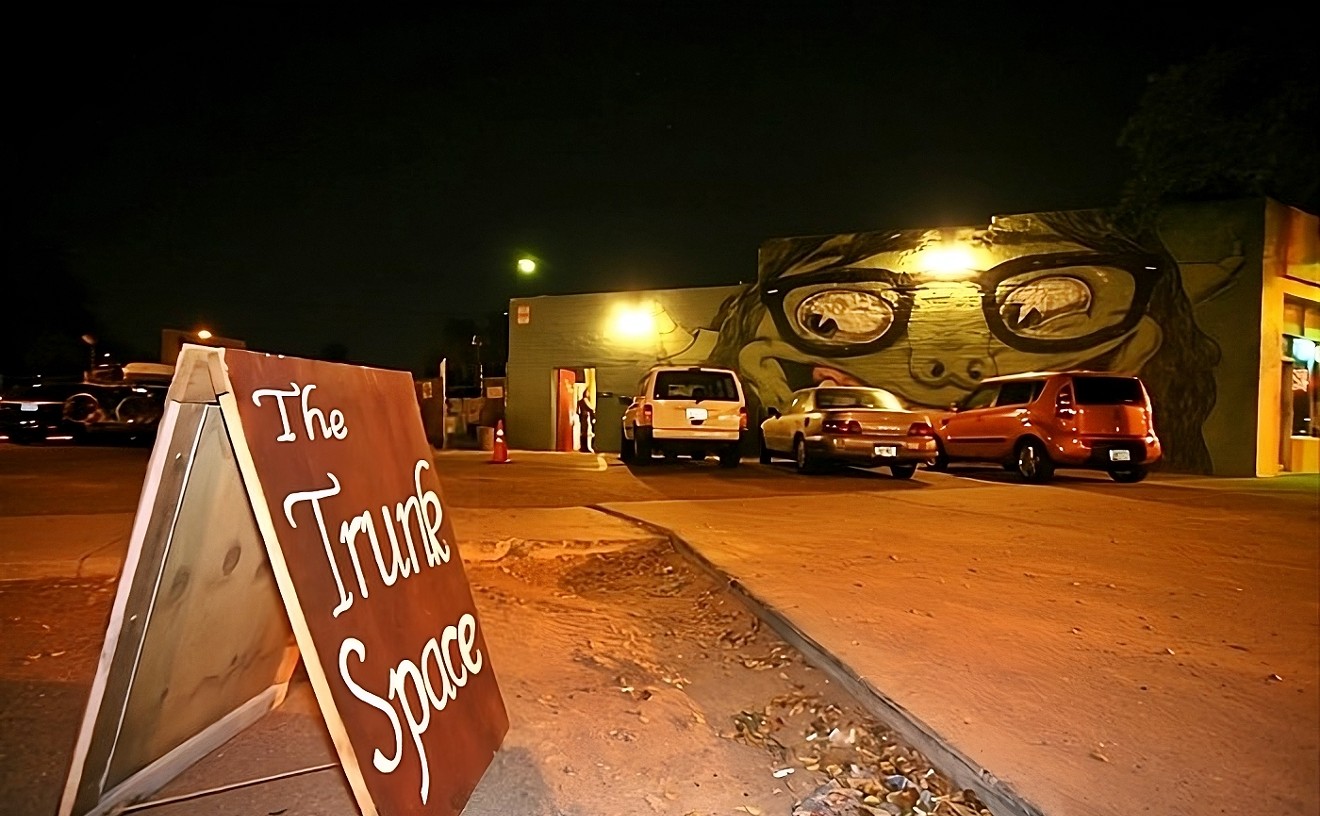Visionary arts and counterculture event Burning Man is akin to a feast for the senses writ large. Very large. Or at least that's how some of the Valley creatives who frequently attend the epic weeklong festival each year out in Nevada's desert hinterlands describe the experience.
It's a seven-day communal hurly-burly of sights and sounds that overflows with an often-surreal surfeit of art, music, and fantastical elements that's attended by more than 50,000 people. Given the unique nature of the event and the unforgettable collection of artwork both bizarre and beautiful that it features, a camera is as much of a necessity as water or camping gear.
See also: Phoenix New Times' Burning Man 2013 Slideshows
Many Burning Man die-hards (a.k.a. "Burners") from around the Valley and throughout Arizona did so when they attended this year's event, which took place over Labor Day weekend, and have allowed us to use some of their many photographs. And believe us, they took a lot of shots.
Photographer Kevin Price (a.k.a. Tripod), who lives in Sierra Vista and has traveled to Burning Man nine different times since 2001, estimates he brought home 100 gigs of photos and videos.
He describes his experience at the 2013 version of the event to have been "awe inspiring," especially when it comes to the sheer scope of the creative efforts on display.
Each year, the virtual community that is formed by attendees out on the desert playa, which is dubbed Black Rock City, features works created by artists from around the world that run the gamut from large-scale installation pieces to colossal and unique structures.
A significant amount of the buildings that are erected are considered temporary (such as the wooden Burning Man effigy and the pyramid-like Temple) and are ritually set on fire on the final night.
But while everything's still in place, the festival offers an art collection that's unparalleled. Few, if any, galleries around the world can rival the sheer enormity, audacity, and pure imagination of the large-scale installations adorning the desert playa that artists spend months or years planning and constructing. Other artists make smaller works that are just as ingenious or otherworldly.
Much of the art at Burning Man reflects it's philosophy of "radical self-expression" and is often inspired by each year's particular theme. To wit: In 2013, it involved the obscure notion of "Cargo Cults." Never heard of it? Well, it's a phenomenon where primitive cultures worship visitors who would literally descend from the skies and bring with them advanced technology other "magical" wonders.
This somewhat esoteric subject matter could pertain to U.S. servicemen parachuting onto South Pacific islands during World War II or aliens arriving on Earth. Hence the number of art works at Burning Man pertaining to UFOs, space travel, or old-timey biplanes.
Even the wooden effigy of the man itself was perched upon a gigantic flying saucer.
There are some projects that weren't necessarily inspired by the theme but seem oddly fitting, such as the wooden sculpture Hands. Designed and built by a team of San Francisco-based Burners, it gives the impression of someone reaching skyward in almost rapturous fashion and awaiting the return of magical visitors.
There are even projects that weren't necessarily inspired by the theme but seem oddly fitting, such as the wooden sculpture Hands that was constructed by a team of San Francisco-based Burners and gives the impression of reaching skyward in almost rapturous fashion.
Price says the piece was one of his favorites.
"I love finding art that seems to be the result of magic," he says. "Usually I look at a piece of art and think, 'I could figure out how to do that, and maybe be as good at that artist some day if I work at it.'"
Another piece at this year's Burning Man that he says was particularly awe-inducing was Truth is Beauty, an titanic 55-foot steel mesh sculpture created by Northern California artist Marco Cochrane that towered over the playa.
"When I looked at Truth is Beauty I knew I was looking at something I couldn't do," he says. "[It was] made with magic!"
Other art installations found at Burning Man each year were a bit more functional in nature but still very creative. Some also reinforce the idea of Black Rock City as a functioning community. For example, the Dust City Diner in a greasy spoon-style eatery that's been setup at each festival since 2006 and serves coffee and grilled cheese sandwiches.
Another aspect of Burning Man that's a unique blend of functionality, creative expression, and weird spirit are the art cars, mutant vehicles, and bizarre bicycles that attendees use to traverse he expansive festival grounds, which stretch for miles.
Each artistically enhanced vehicle is propelled through a variety of different means (ranging from gas motors to old-fashioned pedal power) and no two are exactly alike.
Some resemble sailing ships that travel the desert seas like the U.S.S. Nevada, which has been appearing at Burning Man every year since the early aughts...
And then there are others transports that seem like the product of a childhood flight of fancy.
Price is part investor in a whimsical beast-like art car called The Party Snail, which was created in 2009 by his friend Van Hovey who transports it to the playa all the way from the Bay Area.
And then there are mutant vehicles that completely defy description and are just cool to look and -- more importantly -- ride.
A number of hometown Burning Man regulars have constructed art cars to take to take to the festival, including Ian Liljeblad. For the past couple of years, the Tempe resident and metal fabricator and a team of more than a half-dozen fellow Burners have driven around the playa in The Movement of Jah People a double-decker Rastafarian-inspired ride resembling a Lion of Judah on wheels.
Other locals bringing unique vehicles to the event include Scottsdale physician Kirk Strawn, who practically has an entire fleet. (In fact, you may have seen some at local events like First Friday.) Since 2009, he's been repurposing enormous old airport fire trucks into rebuilt rides, like "Walter - The World's Largest VW Bus" (a 13-foot-by-30-foot recreation of a vintage microbus).
His latest project is called Heathen and is a 10-foot-long horned fire truck that hauls a mobile dance club called Kalliope behind it. Oh, and he also built an oversized VW bug (think Herbie on steroids) called Big Red.
All three of Strawn's rides are quite eye-catching, especially at night. Much like any other vehicles at Burning Man, each comes alive with a slew of neon and LED lights when the sun starts setting. In fact most everything at Burning Man lights up at night, including the sculptures, the art, the buildings, and the Burners themselves.
For some attendees its glow-toys and fluorescent body paint. Those who are into fire-dancing and other flow artistry break out the poi and other ignitable accessories to create epic-looking movements that resemble maelstroms of flames.
Local artist and fire-dancer Corrine Vivers is one of that sort. The Valley resident has been going to Burning Man for so long (seven years to be exact) that she considers herself to be a "lifer." The festival is of such importance to both Vivers and her fiancé John Cardinale that they decided to get married at this year's event outside.
The nuptials took place outside of the photoChapel, a 40-foot-tall structure similar to a Gothic cathedral and covered with photos that was created by Northern California's Michael Garlington and his crew.
Vivers and Cardinale felt it was "the best venue" for the occasion.
"We both love the burn. I live for it every year. This is a second marriage for each of us, so we didn't feel the need to have a huge, fancy ceremony with our extended families invited. I felt it was more important to have my chosen family there," she says. "When we started discussing it, the photoChapel was announced and that kind was kind of the final ingredient. I love that artist and the installation was so magnificently perfect."
Suffice it to say, Burning Man is considered to be an important event for practically all of its attendees; some base the entire year around it. It could be a respite away from the rest of the world, a pilgrimage of sorts, or just a something that brings a slew of emotions.
"I love the art and how it morphs and evolves every year. I love bringing art to display in Center Camp every year," Vivers says. "I love seeing my friends from all over the world. Most of the time it isn't even planned. We just bump into each other while wandering the playa."
Kevin Price, on the other hand, sums up his experience this yearas being "participatory, gratifying, enlightening, humbling, rejuvenating, inspiring [and] exhausting."
And perhaps nothing is as emotionally exhausting as the event's climax on the final evening: the eponymous torching of the Burning Man effigy, the Temple, and many of the other structures. Vivers says it's a cathartic experience.
"Burning Man has become my reboot, my new year," she says. "I put my heart completely into it every year and then pick it up from the ashes of the temple, reborn and whole again."
It's followed by one last blast of revelry and then everyone begins packing up, packing out their trash (the event is strictly a "leave no trace" sort of affair) and heading home the next day during what's called "The Exodus." Needless to say, it results in long lines to leave the playa, which some turn into another excuse to party before returning to reality.











